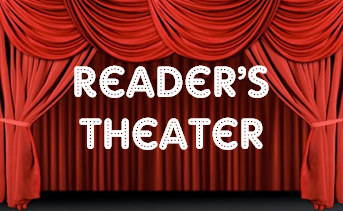READER’S THEATER
by Renee Ann Smith
A Reader’s Theater is a performance where actors focus on vocal expression—rather than visual elements—to help the audience understand the story. It whittles a performance down to its simplest form, which makes a Reader’s Theater attainable for any size class or age range of students, thus perfect for homeschool!
Also, it’s easy on the teacher. Forget about sets, costumes, intricate blocking, and choreography. All your students need to do is read!
Performing a play or piece of literature in this way often increases students’ enthusiasm for reading aloud and encourages reluctant readers to delve into more complicated stories than they would attempt on their own. Also, a Reader’s Theater gives students entry-level experience with drama in a way that many find less intimidating than acting on stage.
For a Basic Reader’s Theater, actors stand on stage (or in the front of the room) in a row or semi-circle. Typically, narrators are placed on each end with the actors in the middle. Though the actors have practiced their parts—and perhaps memorized many of their lines—they hold their scripts (or use lecterns) and alternate between referring to their scripts and looking out at the audience.
Scene changes are usually handled in one of two ways. Either all actors, except for those who are speaking, stand frozen, or actors turn their backs on the audience at various times to make scene changes obvious. In any case, all actors remain on stage together for the entire length of the performance.
If you are unfamiliar with Reader’s Theater, you may want to educate yourself by watching samples on YouTube. You could then show clips of the samples you find to whet your students’ appetites for this activity.
Here are a few simple steps to help you direct a Reader’s Theater:
- Choose a script. Use an existing play or adapt a short story by framing every scene within dialog. Use a script from an old radio or television show. (Did you know scripts for the original Twilight Zone series were often based on short stories?) With one simple Google search, I turned up reliable sites offering scripts for every reading level. (See the resource list below.)Once you find a great script, you may need to edit for length or to accommodate the number of actors in your performance. This may include combining several parts into one composite character or dividing narration among several students.
Though there are many ways to obtain age-appropriate material, doing this step well takes some time.
- Copy your scripts and put them into binders or folders.
- Assign roles and give students time to highlight their parts.
- Begin practicing. As students read, guide them in using voice inflection to interpret the emotion of the lines. Provide tips on how to remain poised in front of an audience. Encourage them to speak clearly, be animated, and have fun!
Once your students are familiar with Basic Reader’s Theater, you may want to attempt Modified Reader’s Theater.
Modified Reader’s Theater is basically like performing an old-fashioned radio drama. This type of performance was popularized in recent years by a play where the actors perform It’s a Wonderful Life as a “live” radio drama. The actors dress in period costumes and use sound effects. They stand in front of the audience and refer to their scripts against a backdrop made to look like the sound stage of a radio broadcast from the 1940’s.
For our Modified Reader’s Theater, my class performed The War of the Worlds radio play from the original script used by Orson Welles in October 1938. To prepare, we watched parts of a documentary about that fateful performance. Then we listened to excerpts of the original radio broadcast so students could hear the way announcers of the time period spoke. As we practiced, we became so confident in our performance that we even threw in sound effects and a few “commercials.”
Now that my class and I have learned to enjoy Reader’s Theater, I plan to feature a similar unit in my curriculum plan every year and would highly recommend the experience for your homeschool.
Resource List:
Sample Reader’s Theater Assessment Rubric
Evaluating Reader’s Theater (Rubrics and More)
Free Reader’s Theater Stories and Scripts
Simply Scripts: TV Scripts, Teleplays and Transcripts
Reading A-Z, Reader’s Theater Scripts
Reader’s Theater Scripts and Plays
Renee Ann Smith teaches literature in a Christian high school by day and writes stories by night. She reviews books and shares inspirational posts on her blog Doorkeeper at http://reneeannsmith.com/. You can also find her on Twitter at https://twitter.com/ReneeAnnSmith.

